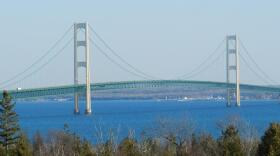You’ve probably heard about harmful blue-green algae on Lake Erie (it's actually not algae at all - it's cyanobacteria). A large bloom of it famously shut down the City of Toledo’s water supply in 2014. But, did you know that cyanobacteria also blooms on Michigan’s inland lakes every year?
On a chilly October morning, ducks break the silence in Cherie Hogan’s yard, and fog rolls off the water. Hogan and her husband have owned their year-round home on Six Mile Lake since 1985.
"It’s a great lake," says Hogan. "It's a great swimming lake, it's a great fishing lake, and, you know, it's a great skiing lake too."
Six Mile Lake is in northern Michigan, located on the upstream end of a chain that includes popular Elk and Torch Lakes.
Hogan says the lake is pristine, otherwise she wouldn’t be able to partake in her favorite waterfront activity.
"Obviously loon-watching," she says. "That's what we love."
On this largely wooded lake, where nesting loons raise healthy chicks, Hogan saw something new this year: harmful blue-green algae, technically called cyanobacteria.

"This year was a strange year, we had the bloom, we've never had it here before," Hogan says. "Then all of a sudden, the conditions just became right and it was in the lake."
Hogan’s lake association had the cyanobacteria chemically treated along the shore with chelated copper and copper sulfate. The bloom was lake-wide, and it lasted for two weeks.
Cyanobacteria can produce toxins. It can give you vomiting and diarrhea if ingested, or a rash from skin contact.
"Certain types of this blue-green algae can be toxic, you know can make your pets sick," Hogan says. "So you shouldn't swim in it and you definitely shouldn't be drinking it, so it was an inconvenience."
Harmful algal blooms are driven in large part by warm temperatures and nutrients from fertilizer running into water bodies. Nutrients from old or improperly maintained septic systems can also contribute.
In the southern part of the state, it’s warmer, and there are just more farms (and lawns) being fertilized. So, you’re more likely to see cyanobacteria there.
But, Aaron Parker of the Michigan Department of Environment, Great Lakes and Energy says he’s seeing more and more blooms up north.
"I seem to be hearing about new lakes in the northern part of the state every year," says Parker. "I'll get a call about a new one that I haven't been to, such as, you know, Six Mile."
Parker says the reason could be the invasion of zebra mussels. The mussels eat other tiny organisms in the water, but they don’t always eat cyanobacteria — giving it an unfair advantage.
“So oftentimes if I do see a bloom that occurs in one of the northern lakes, one of the first things I look at is, is there a known zebra mussel presence in there," says Parker. "Because now even in your low and medium nutrient lakes, such as is common in northern Michigan, we're starting to see cyanobacteria blooms in those too.”
The State of Michigan has confirmed cyanobacteria on more than 70 Michigan lakes since 2016. But Parker says that with more than 11,000 lakes in the state, he doesn’t consider the problem widespread. Monitoring of blooms relies heavily on people calling in to report them.
“If were to take a dart and throw it at a map of Michigan and then go and sample the closest lake to wherever that dart landed, the chances that I'm going to find a cyanobacteria bloom [are] not very likely," he says.
But, it’s possible we’ll see even more blooms as zebra mussels spread and as the climate warms.
"If it continues to get warmer as you progress further north in the state, then yes we could see increased instances of cyanobacteria blooms up in the northern parts of the state," says Parker.
Dave Edwards is the Monitoring and Research Director with Tip of the Mitt Watershed Council. He says one of the best things lakefront property owners can do is keep nutrients from getting in the water in the first place.
“Well I can say that the most beneficial or healthy shoreline practice would be to maintain a buffer zone between a residential property or a cabin and the lakeshore," says Edwards. "A healthy abundance of native vegetation, woody plants, not having a mowed lawn right up to the waters' edge is a beneficial practice for people to do.”
Edwards confirms that his organization is just starting to encounter harmful algae blooms in their service area, which is Antrim, Charlevoix, Cheboygan and Emmet counties.
“It's relatively new for us, so we don't have much to go on," he says.
But, they’re actively documenting any blooms they discover.
Copyright 2019 Interlochen Public Radio




